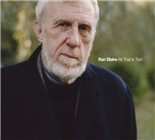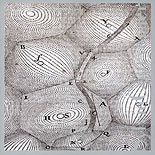Home » Jazz Articles » Multiple Reviews » A Queue of Contemporary Keyboardists: Ran Blake, Howard Riley, S
A Queue of Contemporary Keyboardists: Ran Blake, Howard Riley, S
 | | |  |
Ran Blake The Complete All That Is Tied Sessions Tompkins Square-emusic.com 2007 | Howard Riley Short Stories (Volume II) SLAM 2007 | Søren Kjærgaard Keys ILK Music 2006 | Sylvie Courvoisier Signs & Epigrams Tzadik 2007 |
The acoustic keyboard has been around for centuries, its myriad musical possibilities explored and re-explored by a host of skillful and creative musicians, exploiting the instrument's extended tessitura and broad capacity for harmony and counterpoint to its seeming fullest. How refreshing, then, that a constantly reforming queue of improvisers is lined up and stepping forward to suggest new avenues of expression, new artistic possibilities. What better showcase for these than a solo piano album? Ran Blake, Sylvie Courvoisier, Søren Kjærgaard, and Howard Riley have all recently released unique and idiosyncratic works that convincingly suggest that the piano's possibilities are far from exhausted.
While all of these artists could huddle under the umbrella category of 'avant-garde', a leaky term covering 'new' improvisational music, they all tip their berets in one way or another to the legacy of jazz. Ran Blake, for example, on The Complete All That Is Tied Sessions, exposes the Americana roots of gospel chording and cadences, the hammered and 'bent' notes of the blues, and the whorehouse ragtime of the Crescent City, all felt or implied without overt imitation. Deeper roots may be discerned in his use of Western European classical composers, notably the piano-friendly texturing of Frédéric Chopin and the modern dynamism of the Third Streamers. Howard Riley's Short Stories (Volume II) reveals the influences of walking bass lines, bop chord voicings and swing, but leans more to the progressive lyricism of Keith Jarrett, the angular phrasing of Thelonious Monk ("Roots nods to Monk's "Misterioso ) and the muscular bombast of Cecil Taylor. Søren Kjærgaard brings a European (Danish) sensibility to the music, though he certainly understands the blues, as on Keys' "Willow Weep for Me , where he makes the cembalo (a woody-toned harpsichord) sound like a National Steel resonator guitar. His reinterpretations of well-known standards such as "Night & Day , "Yesterdays and "Body & Soul allow attentive listeners to discern the method beneath his mania; on the latter tune—akin to the narrative structure of Toni Morrison's Beloved or William Faulkner's The Sound & the Fury—his musical plot, at first opaque, is gradually unveiled. Of the four keyboardists, Sylvie Courvoisier is perhaps the least obviously indebted to the straight-ahead school; on Signs and Epigrams, her employment of chromatic and symmetric 'scales' and cliché-free thematic development is patently autonomous; her 'roots' stem rather from the pure-sound aesthetics of ecstatic jazz.
Each of these artists, in their own ways and means, unfold the envelope in search of the novel; all share an interest in expanding the timbral palate of the piano, whether through layered textures or extended techniques. Blake accomplishes the former through fairly conservative use of unorthodox articulations and unexpected juxtapositions, relying on an organic sense of dramatic tension to forward his narratives. Riley reaches into the sound-box to create impromptu, 'unprepared' piano pitches, as on "Concision and "Passing ; elsewhere, his incessant ideations, featuring audaciously independent right- and left-hand 'personalities', coalesce in a textural gestalt of high density and intensity. On the first disc of Keys, Kjærgaard confines himself to the keyboard, at times waxing rhapsodic in unpredictable serpentine shapes, at others spinning Zen tone-webs of surprising span, as on "Izerka and "Bye Lulla ; on the second disc he investigates the unusual hues of the celeste, cembalo, glockenspiel and pump organ—to fresh effect. Courvoisier heads straight for the naked strings, firing off "Ricochet with damped, impressionistic bass notes, then proceeding through a variety of hands-on procedures—harmonics, behind-the-nut plucking, string-hammering, scratching and bending—to enhance and augment her concepts. Her pieces, cohesively structured through evolving motifs, are atmospheric and patently open-ended, programmatic without losing a sense of wholistic growth and discovery.
These contemporary keyboardists are stepping up and out, finding fountains of youth in an age-old instrument.
Tracks and Personnel
The Complete All That Is Tied Sessions
Tracks: All That Is Tied (alternate take); Arline; Field Cry (alternate take); Field Cry (alternate take); Indian Winter; Latter Rain Christian Fellowship (alternate take); Sister Tee; Sontagism (alternate take); Spiral Staircase; Straight Ahead; Touch of Evil; Turning Point; Vanguard; Wende (alternate take).
Personnel: Ran Blake: piano.
Short Stories (Volume II)
Tracks: Disc 1: Geocentric One; Up & Downs; With Ease; The Gap; Think Again; Geocentric Two; Palmate; Walkabout; Reconciliation; Branch Lines; Head Games; Splits; Concision; Shenanigans; Maybe.
Disc 2: Another Time; No Regrets; Ascending; Still Standing; Threesome; Of the Moment; Reflective Tendencies; Inevitably; Sentiments; Open Question; Hidden Knowledge; Meeting; Hear Me Out; Passing; Roots.
Personnel: Howard Riley: piano.
Keys
Tracks: Disc 1: Night & Day; Yesterdays; Stella; Mr. Tutu's Dance Cycle; Ballad for Leo; Now Piece #1; Body & Soul; Lovething; Now Piece #2; Lines ; Space; What's New; Prelude; Izerka; Bye Lulla.
Disc 2: I Remember You; Willow Weep for Me; BrotherSister; Mojave Rattlesnake; Kubrick; Lemmy Caution; Single Petal of a Rose.
Personnel: Søren Kjærgaard: piano, celeste, cembalo, glockenspiel, pump organ.
Signs & Epigrams
Tracks: Ricochet; Des Signes et des Songes; Meccania; Epigram 1; Epigram 2; Epigram 3; Confins de Lueurs; Chick; Mis en Pièces; Soliloquy.
Personnel: Sylvie Courvoisier: piano.
< Previous
jazz, JAZZ, jazz
Next >
My Island
Comments
Tags
For the Love of Jazz
 All About Jazz has been a pillar of jazz since 1995, championing it as an art form and, more importantly, supporting the musicians who create it. Our enduring commitment has made "AAJ" one of the most culturally important websites of its kind, read by hundreds of thousands of fans, musicians and industry figures every month.
All About Jazz has been a pillar of jazz since 1995, championing it as an art form and, more importantly, supporting the musicians who create it. Our enduring commitment has made "AAJ" one of the most culturally important websites of its kind, read by hundreds of thousands of fans, musicians and industry figures every month.



















